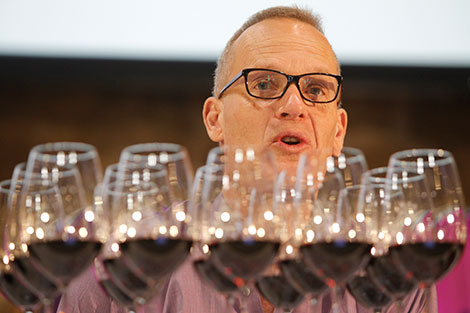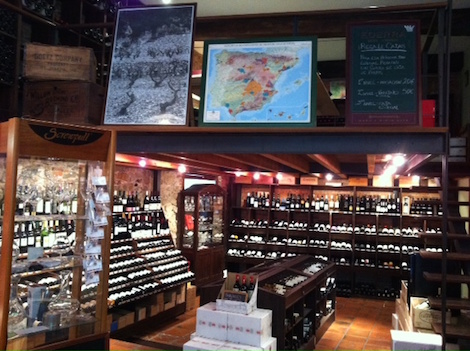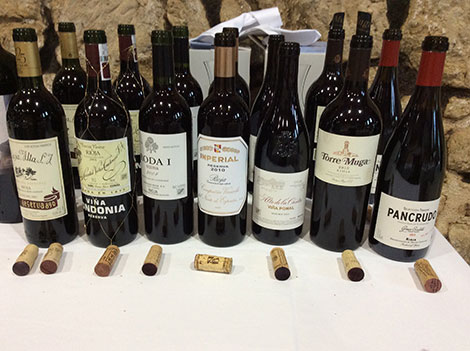
The wineries in Haro’s venerable Barrio de la Estación have joined forces for the first time to show their history and wines to the world and Tim Atkin is partly to blame for that feat. About a year ago, the British Master of Wine encouraged Guillermo Aranzabal, La Rioja Alta director, to get the district’s seven producers on board to organize an event to showcase the area’s many strong points.
“The Barrio is the soul of Rioja and a bridge between the past and the future; a gorgeous place which is still missing the worldwide recognition it deserves in a crucial moment for the region”, says Atkin. He is the master of ceremonies at a tasting for 500 professionals and 14 wines ranging from 1981 to 2013 such as Viña Tondonia Gran Reserva 1981, Prado Enea Gran Reserva 1994 or Roda I Reserva 1994 which preceded 21st century examples like Gran Reserva 890 Selección Especial 2001, Imperial Reserva 2010 and culminated with the modern Pancrudo 2013, the fresh and vibrant Garnacha by Gómez Cruzado.
After the tasting held in two shifts at Bodegas Bilbaínas, Atkin expresses out loud what many in the audience think: “Rioja should focus more on grapes, vineyards, terroir and soil types. The Consejo Regulador (Control Board) is deeply conservative and is dominated by cooperatives and the big volume players, but the future lies on its villages and pagos (single vineyards), although I don’t know whether that will ever happen”. Masters of Wine Pedro Ballesteros and Sarah Jane Evans, who are at the tasting, nod in agreement.
The railway line, a key element
Such a future, remembers María José López de Heredia, springs from the work of the first pioneers who settled at Barrio de la Estación and worked the vineyards to grow quality grapes. “By 1900 my great grandfather wanted to sell wine to gentlemen who wore ties, spoke English and were connected to the Royal Household”, she says.
It was achieved thanks to the train, which transported wine to Bilbao and from there sailed on boats to Bordeaux, and also to the train station, which was built in 1864, recalls wine anthropologist Luis Vicente Elías Pastor during an instructive and entertaining presentation about the district before the tasting.
“Although wine had long been produced in the area, wines in the 18th century were said to be bland and violent”, he explains. The first cadastral map dating from 1913 includes some bodegas, but it was the French merchants who arrived after an oidium plague decimated vineyards in Bordeaux in 1846-1848, who built the warehouses that are the seed of the development of the Barrio and the large-scale plantation of vineyards (68,000 hectares by 1891).
Traders like Armand Heff, who produced sparkling wines in Valladolid or Sauternes and Barsac with Viura, were said to “marinade” the wine and transport it. “The station was fundamental in the development of the wine trade, but it was very close to being built somewhere else in Haro. If the alternative location had gone ahead, the Barrio would not exist today”, explains Elías.
Modernity, represented at the time by the industrial estate that was Barrio de la Estación, is nowadays a group of seven wineries —Cvne, Gómez Cruzado, La Rioja Alta, Bodegas Bilbaínas, López de Heredia, Muga y Roda— which welcome half a million visitors a year and produce wines with diverse styles. The challenge now is to achieve strength through unity.
Long-term union
The first steps towards this partnership took place when the Barrio de la Estación Tourist Development Association was set up in 2007. Back then, the focus was the creation of a pedestrian area but the project came to a standstill as it required the expropriation of some old vines. When the Barrio neighbours started to discuss the tasting event, the association picked up again, says manager Iñigo Torres.
“We’ve been preparing this event for a whole year and the idea is to carry it forward”, he explains. They are pondering a change of dates; as the harvest has been brought forward some neighbours are already in the midst of bringing in grapes so the day-to-day running of the wineries has been affected.
The cost of the two-day event has reached €300,000 which has been covered by the sponsors, wineries and ticket sales. “Almost 50% of the 3,500 people who purchased their ticket online chose the VIP option (€40), which includes 14 of the seven wineries’ most singular wines. People are interested”, Torres concludes.
The event is limited to 4,000 people and attention to detail has been paramount: proper glasses (Schott Zwiesel) are handed in with the ticket; a service mark has been printed to avoid that the fun turns into binge drinking. Unlike many Harvest Festivals, the Haro Wine Experience is a popular fiesta where both producers and aficionados appreciate wine culture. Aside from an English couple who moans that their dogs have not been allowed in Bodegas Muga and some complaints about the queues to buy extra tapas tickets, there are hardly any incidents.
Photocall, rackings and plenty of jazz
The standard €20 ticket includes the tasting of seven wines and three tapas made on site by some local restaurants. There are parallel activities in each of the seven wineries like live manual rackings in La Rioja Alta, artisan barrel taming at Muga or an artist painting a traditional mural on the walls of Gómez Cruzado. At the manicured gardens of Bodegas Bilbaínas, wine lovers pose on a Chesterfield sofa with props from the roaring twenties to get their picture taken. Kids are also having fun at the 30-min workshops where they paint and make necklaces and key rings out of corks while punters at the gastro area dance along the jazz sounds played by two live bands.
“Events like this are beneficial for the whole region,” acknowledges Tom Puyaubert from Bodegas Exopto while he enjoys a glass of Pancrudo, the new Gómez Cruzado Garnacha. Carmen Enciso (Bodegas Valenciso) has also taken the day off to come to Haro. “We must make the best out of this opportunity to taste great wines”, she says.
There are many people from Logroño, who have traveled on special trains chartered for the event, but Basque, Catalan or English is also heard among the crowds. Zig and Kim have come from New Jersey in the US to spend their vacation in Spain; as keen wine lovers, they like to visit wine regions so a trip to Rioja was inevitable. They have tasted Muga in the US and are in Haro with Jose, their guide from Wine Taste Lovers. “We like Tempranillo, but it isn't easy to find a good selection of Spanish wines where we live. We knew that Rioja was an important wine-producing area, but this is much better than we expected; we have visited wineries in California but we love this atmosphere and the area in general”, they say as they enjoy a glass of Viña Tondonia Reserva 2001.
While the Dixie Band plays on the courtyard of Bodegas Roda, Fede, Icíar, Mari Carmen and Javi explain that they have come from Bilbao for the Wine Experience. They are staying at at hotel in Haro (“the last rooms available”) and have arrived at the Barrio at 11, when the wineries have opened their doors. “We think it’s very well organized; there was a bit of a queue to pick up the tickets but it has moved pretty fast. We know the wines so it’s a great opportunity to try Roda I 2008, Imperial 2010 or Gran Reserva 904 2005”, adds Fede.
Alejo and his wife are buying some wines at the Gómez Cruzado shop. “We live in Brasil, but I’m Catalan”, says Alejo. “We are on holidays in Barcelona, but we heard about this event so we came over. I’m a wine enthusiast so I didn’t want to miss it; events like this are not common in this country”.
As the train station receives more wine fans, the organizers are happy with the event, says Torres, but this is just the first step of what they want to achieve. There’s plenty of work to do. As María José López de Heredia says, “you cannot love what you don’t know”.

Yolanda Ortiz de Arri
A journalist with over 25 years' experience in national and international media. WSET3, wine educator and translator
NEWSLETTER
Join our community of Spanish wine lovers






